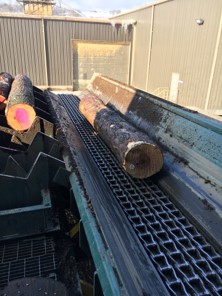
In 2021, the average newly constructed wood-frame home was 2,540 square feet (236 m²). Did you know this requires more than 15,000 board feet to complete? The importance of the forestry industry for things such as paper, lumber and panels cannot be understated. Compressed air also plays a vital role in the forestry industry – an industry we all rely on.

One Sullair customer produces more than 90 million feet of lumber annually, including between 55,000–65,000 feet per 10-hour shift. This mill typically runs on two 50 hp compressors and one 100 hp compressor, as the air is used in nearly every process.
Applications at a mill – many of which require compressed air – include:

Debarking, or the removal of bark from a log, is the first step of the process. A metal detector is used just prior to the debarker to detect tree sap taps. The logs are moved by air cylinders, requiring compressed air, as does the debarker arms to spin and strip bark.
Kickers are used in between the debarker and the head saw to flip logs, which also typically require around 900-110 psi of air. A head saw cuts the stumps into cants or unfinished logs, also requiring compressed air to keep the pressure on the saw.
After debarking/head saw cutting, an edger cuts the edges of the boards, and all cut boards go through an accumulator pit. A scrambler is then used to bring boards up to the lumber grader. Each piece of lumber is sorted into various grades based on visual characteristics known to affect lumber strength and stiffness, such as knot size and slope-of-grain. Lasers then scan the lumber for length, width and height.
A lumber scaling ruler is used to determine the quantity of wood in terms of board feet in individual boards.
Lumber is then dried using a complete compressed air system. Did you know pine lumber typically shrinks 0.5 in (12.7 mm) and hardwood is cut 1/8” larger than necessary so that it dries to its true size?
With many forestry customers operating 24 hours a day, they need to rely on an efficient and dependable compressed air system. Downtime simply isn’t an option. Contact your local Sullair distributor to learn more about how Sullair compressed air solutions serve the forestry industry.
Use the checkboxes to select the types of cookies you want to accept, then press the “Save Settings” button. View our Privacy Policy.